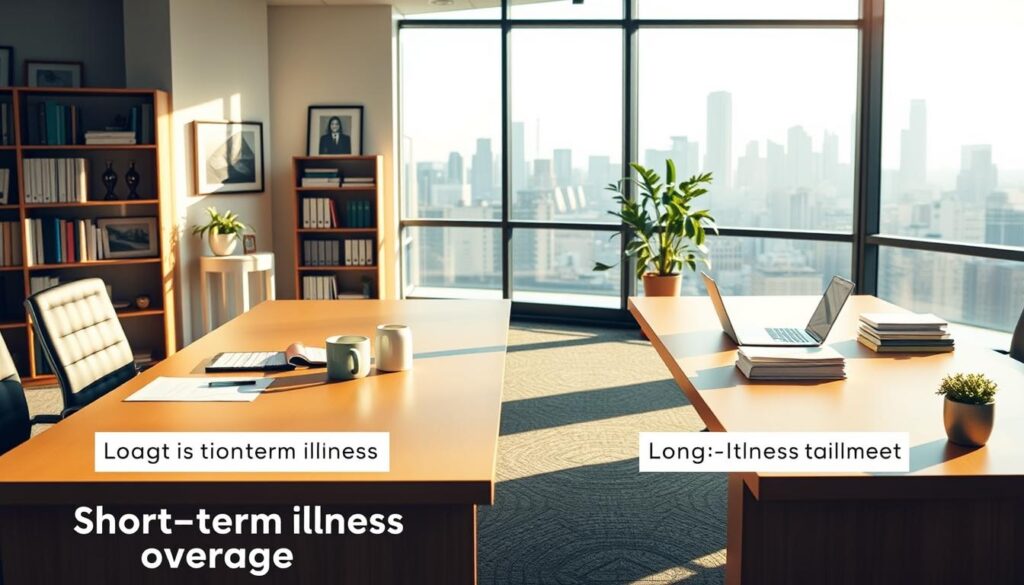Navigating healthcare options can feel overwhelming, especially in a dynamic place like Singapore. Understanding your choices ensures you get the right protection for your needs. Whether you’re a local or an expat, having the right plan can make all the difference.
This guide helps you explore various plans, from basic MediShield Life to enhanced private options. Integrated Shield Plans (IPs) offer expanded coverage, while CPF MediSave accounts make premium payments easier. Tailored solutions are also available for frequent travelers.
With healthcare costs rising, it’s essential to analyze cost-saving strategies. Learn about the differences between public and private hospital wards and how riders can reduce out-of-pocket expenses. Stay updated with recent changes, like expanded cancer drug coverage effective April 2023.
Key Takeaways
- Compare MediShield Life with private insurance options.
- Understand how Integrated Shield Plans expand coverage limits.
- Use CPF MediSave accounts for premium payments.
- Explore tailored solutions for expats and travelers.
- Stay informed about recent healthcare policy changes.
Introduction to Medical Insurance in Singapore
Protecting your health starts with the right coverage plan. In Singapore, having a reliable healthcare plan is essential for managing unexpected medical costs. Whether you’re a local or a permanent resident, understanding your options ensures you’re prepared for any situation.
Why Medical Insurance is Essential
Healthcare expenses can add up quickly, especially in emergencies. A good plan helps cover costs for hospital stays, surgeries, and treatments. Without it, you might face significant financial strain. For singaporeans permanent residents, having coverage is not just a choice—it’s a necessity.
Overview of MediShield Life
Launched in 2015, MediShield Life is a government-managed basic coverage plan. It’s designed to provide essential protection for all citizens and permanent residents. Premiums can be fully paid medisave, making it accessible for most individuals.
Here’s a quick look at its key features:
| Feature | Details |
|---|---|
| Coverage | Class B2/C wards in public hospitals |
| Surgical Coverage | Up to S$2,600 |
| Annual Claim Limit | Rising to S$200,000 in 2025 |
| Exclusions | Maternity care, hospice services, overseas emergencies |
| Integration | Works with Integrated Shield Plans for enhanced protection |
While MediShield Life offers basic protection, it’s important to note its limitations. For example, it doesn’t cover overseas treatments or certain specialized services. However, it’s a solid foundation for anyone looking to safeguard their health.
Understanding Integrated Shield Plans (IPs)
Healthcare plans are designed to provide security during unexpected medical situations. Integrated Shield Plans (IPs) take this a step further by offering enhanced coverage options. These plans work alongside MediShield Life to ensure you’re fully protected.
What are Integrated Shield Plans?
Integrated Shield Plans are private add-ons to the basic MediShield Life coverage. They provide higher claim limits and access to private hospitals. This means you can choose specialists and facilities that best suit your needs.
These plans also cover advanced diagnostics like PET scans and treatments for congenital abnormalities. Optional international coverage is available for those who travel frequently.
How IPs Complement MediShield Life
While MediShield Life offers basic protection, IPs expand its benefits. For example, the claim limit increases from S$100,000 to S$1 million. Deductibles for B1 wards are reduced from S$2,500 to S$1,500.
Here’s a quick comparison of the two:
| Feature | MediShield Life | Integrated Shield Plans |
|---|---|---|
| Claim Limit | S$100,000 | S$1,000,000 |
| Ward Type | Class B2/C | Private/A-Class |
| Deductible (B1 Ward) | S$2,500 | S$1,500 |
| Specialist Selection | Limited | Full Access |
With these benefits, shield plans ensure you’re covered for a wide range of medical needs. Whether it’s inpatient psychiatric care or major organ transplants, IPs provide comprehensive protection.
Types of Health Insurance Plans Available
Health plans come in various forms, each designed to meet specific needs and lifestyles. Whether you’re looking for basic protection or comprehensive coverage, there’s a plan that fits your requirements. Let’s explore the different options available.
MediShield Life: Basic Coverage
MediShield Life is the foundation of health protection in Singapore. It covers essential treatments in public hospital wards, ensuring you’re protected against high medical costs. Premiums can be paid using MediSave, making it accessible for most individuals.
Integrated Shield Plans: Enhanced Coverage
For those seeking more extensive protection, Integrated Shield Plans (IPs) are a great option. These plans work alongside MediShield Life to provide higher claim limits and access to private hospitals. They also cover advanced treatments and diagnostics.
IP Riders: Additional Benefits
Riders are add-ons that enhance your IP coverage. They can reduce out-of-pocket expenses and provide extra benefits like coverage for pre-existing conditions or maternity care. Riders ensure your plan is tailored to your specific needs.
International Health Insurance: Global Coverage
For frequent travelers, international health plans offer global protection. These plans cover medical evacuation, preventive care overseas, and even adventure sports injuries. They’re essential for those who need coverage beyond Singapore.
Here’s a quick comparison of these plans:
| Plan Type | Key Features |
|---|---|
| MediShield Life | Basic coverage, public hospital wards, MediSave payments |
| Integrated Shield Plans | Higher claim limits, private hospital access, advanced treatments |
| IP Riders | Reduced out-of-pocket costs, pre-existing condition coverage |
| International Plans | Global coverage, medical evacuation, 24/7 support |
Understanding these options helps you choose the right plan for your needs. Whether you’re looking for basic or comprehensive insurance coverage, there’s a solution that fits your lifestyle.
Key Features of the Best Medical Insurance Singapore
Choosing the right healthcare plan involves understanding its key features and benefits. A comprehensive plan not only covers hospital stays but also extends to pre- and post-hospitalization care. Let’s explore what makes these plans stand out.

Higher Claim Limits
One of the standout features is the higher claim limits. This ensures that even major medical expenses are covered without financial strain. Whether it’s a complex surgery or long-term treatment, you can focus on recovery rather than costs.
Coverage for Private Hospitals
Access to private hospitals is another significant advantage. These facilities often offer shorter wait times and more personalized care. With this coverage, you can choose specialists and treatments that best suit your needs.
Pre- and Post-Hospitalisation Treatments
Comprehensive plans include pre- and post-hospitalization care. This means you’re covered for up to 180 days before admission and 365 days after discharge. Here’s what this typically includes:
- Diagnostic scans and blood tests
- Rehabilitation therapies
- Mental health follow-ups
- Home nursing services
- Medical equipment rental
These treatments ensure a smooth recovery process, addressing both immediate and long-term health needs.
Understanding these features helps you make an informed decision. Whether it’s higher claim limits, private hospital access, or extended care, the right plan offers peace of mind and comprehensive protection.
Comparing Top Medical Insurance Providers
Selecting the right healthcare provider can significantly impact your financial and physical well-being. With various options available, understanding the features and benefits of each plan ensures you make an informed choice. Let’s explore some of the top providers and what they offer.
Provider A: Plan Features and Benefits
Great Eastern SupremeHealth P Plus is a standout option for those seeking comprehensive coverage. This plan integrates traditional therapies with modern healthcare solutions, ensuring holistic care. Here are some of its key features:
- Integrated with GELA app: Manage your plan and track claims effortlessly.
- Health screenings: Regular check-ups to monitor your well-being.
- Vaccination coverage: Protection against preventable diseases.
- Chronic disease management: Support for long-term health conditions.
- Mental health coverage: Access to counseling and therapy services.
- Overseas emergency coverage: Peace of mind while traveling.
- No-claim bonus rewards: Incentives for maintaining good health.
- Family package discounts: Affordable options for your loved ones.
- Critical illness accelerator: Enhanced support for severe conditions.
- Palliative care coverage: Compassionate care during challenging times.
This plan is designed to meet diverse healthcare needs while keeping premiums affordable. Whether you’re managing a chronic condition or planning for future health concerns, it offers reliable protection.
Factors to Consider When Choosing a Plan
Deciding on the right healthcare plan requires careful thought and planning. With so many options available, it’s important to evaluate your needs and priorities. This ensures you select a plan that provides the right level of protection without unnecessary costs.

Your Healthcare Needs
Start by assessing your health requirements. Do you need basic protection or more comprehensive coverage? Consider factors like pre-existing conditions, family history, and lifestyle. For example, frequent travelers may benefit from international plans, while those with chronic conditions might prioritize riders for added support.
Budget and Premiums
Your budget plays a key role in choosing a plan. While higher premiums often mean better coverage, it’s important to find a balance. Look for plans that fit your financial situation without compromising on essential benefits. Don’t forget to check if premiums can be paid using MediSave for added convenience.
Coverage Limits and Exclusions
Understanding the terms conditions of your plan is crucial. Pay attention to coverage limits, exclusions, and waiting periods. Some plans may exclude experimental treatments or limit mental health coverage. Others might have age-related benefit reductions or pandemic-related clauses. Always review the fine print to avoid surprises later.
Here are some key points to keep in mind:
- Waiting periods for certain treatments.
- Lifetime benefit maximums and how they apply.
- Exclusions for cosmetic procedures or dangerous activities.
- Pre-authorization requirements for specific treatments.
- Claim documentation process for smoother reimbursements.
By considering these factors, you can choose a plan that meets your needs and provides peace of mind. Take your time to compare options and ask questions to ensure you’re making the right decision.
Healthcare Inflation and Its Impact on Insurance
Healthcare costs are rising globally, and Singapore is no exception. This trend has a direct impact on the cost of coverage plans, making it essential to understand how inflation affects your financial planning. Whether you’re considering basic or enhanced protection, staying informed helps you make better decisions.
Understanding Healthcare Inflation
Healthcare inflation refers to the steady increase in medical expenses over time. Factors like advanced treatments, higher demand for services, and rising operational costs contribute to this trend. For example, MediShield premiums are set to increase by 35% between 2025 and 2028. Integrated Shield Plans (IPs) also undergo adjustments every three years to reflect these changes.
How It Affects Your Insurance Premiums
As healthcare costs rise, so do the premiums for coverage plans. This can strain your budget, especially if you’re on a fixed income. Here are some key factors to consider:
- Age-band premium restructuring: Premiums increase as you age, reflecting higher healthcare needs.
- Benefit reduction options: Some plans allow you to lower premiums by reducing coverage limits.
- Deductible increases: Out-of-pocket costs may rise over time to offset inflation.
- Co-insurance percentage changes: You may need to pay a higher share of medical expenses.
- Rider cost escalations: Add-ons that enhance coverage can become more expensive.
Policy renewal is another critical factor. As you age, your premiums may increase significantly, impacting long-term financial planning. Multi-generational coverage and group insurance alternatives can help mitigate these costs. Additionally, health savings accounts provide a way to set aside funds for future medical needs.
By understanding these dynamics, you can make informed choices about your coverage. Whether it’s adjusting your plan or exploring alternative options, staying proactive ensures you’re prepared for the impact of healthcare inflation.
Short-Term vs. Long-Term Illness Coverage
Understanding the difference between short-term and long-term illness coverage can help you make informed decisions. Whether you’re dealing with a sudden hospitalization or managing a chronic condition, having the right plan ensures you’re prepared for any situation.

Coverage for Short Hospitalization
Short-term plans are designed to cover immediate medical needs, such as surgeries or injuries. These plans typically include hospital stays, diagnostic tests, and follow-up treatments. However, they may not cover pre-existing conditions or long-term care.
For example, if you’re recovering from an accident, a short-term plan can help with hospitalization costs. But for ongoing treatments, you’ll need a more comprehensive solution. Short-term plans are ideal for new illnesses or injuries during a limited period.
Coverage for Long-Term Illnesses
Long-term plans provide support for chronic conditions like diabetes, cancer, or heart disease. These plans often include benefits like home nursing, rehabilitation programs, and palliative care. They also cover pre-existing conditions, making them a better choice for ongoing health management.
For instance, ElderShield supplement plans offer additional support for long-term care needs. They include features like income replacement options and family caregiver support. This ensures you’re covered for both medical and non-medical expenses.
Here are some key benefits of long-term coverage:
- Critical illness riders: Extra protection for severe conditions.
- Chronic condition management: Support for ongoing treatments.
- Home nursing coverage: Assistance for recovery at home.
- Palliative care benefits: Compassionate care during challenging times.
- End-of-life planning: Guidance for terminal illness lump sum payouts.
By understanding these options, you can choose a plan that fits your health needs and provides peace of mind. Whether it’s short-term hospitalization or long-term illness management, the right coverage ensures you’re protected.
Life Insurance vs. Health Insurance
Life and health insurance serve different purposes, but both are essential for financial security. While health insurance focuses on covering medical expenses, life insurance provides financial support to your loved ones in case of your passing. Understanding these differences helps you choose the right plan for your needs.
Whole Life Insurance
Whole life insurance offers lifelong protection with a savings component. It ensures that your beneficiaries receive a payout regardless of when you pass away. This type of plan is ideal for those looking for long-term financial security and estate planning.
Key features of whole life insurance include:
- Fixed premiums: Payments remain the same throughout the policy term.
- Cash value accumulation: A portion of your premium builds cash value over time.
- Death benefit: Guaranteed payout to your beneficiaries.
- Loan options: Borrow against the cash value if needed.
Term Life Insurance
Term life insurance provides pure protection with no savings component. It covers a specific period, usually up to 30 years, and is more affordable than whole life insurance. This plan is perfect for those seeking temporary coverage, such as mortgage protection or income replacement.
Here are some benefits of term life insurance:
- Renewable terms: Extend your coverage after the initial term ends.
- Convertible options: Switch to a whole life policy without a medical exam.
- Critical illness riders: Add extra protection for severe health conditions.
- Accidental death benefits: Additional payout for accidental deaths.
Here’s a quick comparison of the two:
| Feature | Whole Life Insurance | Term Life Insurance |
|---|---|---|
| Coverage Duration | Lifetime | 10-30 years |
| Savings Component | Yes | No |
| Premiums | Fixed | Lower, but may increase upon renewal |
| Flexibility | Loans against cash value | Convertible to whole life |
Choosing between whole life and term life insurance depends on your financial goals and needs. Both plans offer valuable coverage, but they cater to different stages of life and priorities. Evaluate your situation carefully to make the right decision.
Hospital Income Insurance Explained
Recovering from an illness shouldn’t mean worrying about lost income. Hospital income insurance provides financial support during hospitalization, ensuring you can focus on healing without added stress. This type of plan is designed to replace lost earnings and cover additional expenses that may arise.
What is Hospital Income Insurance?
Hospital income insurance is a supplemental plan that pays a daily or monthly benefit during hospitalization. It’s not tied to medical bills but instead provides cash to help with everyday expenses. This ensures you can maintain your lifestyle even when you’re unable to work.
Benefits and Coverage
This type of plan offers a wide range of benefits to ease financial strain. It’s particularly useful for those who rely on their income to cover daily expenses. Here’s what it typically includes:
- Income replacement: Provides financial support during recovery.
- Coverage for loss of employment: Protects against job-related income loss.
- Supplemental childcare costs: Helps with additional caregiving needs.
- Home modification benefits: Covers changes to your living space for recovery.
- Transportation cost coverage: Assists with travel to and from medical appointments.
- Mental health day coverage: Supports mental well-being during recovery.
- Post-hospitalization benefits: Extends support after discharge.
- Worldwide coverage options: Ensures protection even when traveling.
- Group policy discounts: Offers savings for families or organizations.
- Return of premium features: Provides refunds if no claims are made.
With a 365-day maximum per condition and coverage for quarantine periods, this plan ensures comprehensive protection. Whether you’re dealing with a short-term illness or a prolonged recovery, hospital income insurance offers peace of mind.
Long-Term Care Insurance
Planning for future healthcare needs is essential for long-term peace of mind. Long-term care insurance is designed to provide financial support for extended health challenges, ensuring you can maintain your quality of life even during prolonged illnesses. This type of plan is particularly valuable for those who may require assistance with daily activities or specialized care over an extended period.
What is Long-Term Care Insurance?
Long-term care insurance helps cover the costs of services like nursing home care, home health aides, and assisted living facilities. It’s designed for individuals who may face challenges with activities of daily living (ADLs), such as bathing, dressing, or eating. This plan ensures you’re prepared for the financial burden of extended care needs.
Benefits and Coverage
This type of plan offers a wide range of benefits to ease the financial strain of long-term care. It’s particularly useful for those who want to protect their savings and ensure access to quality care. Here’s what it typically includes:
- Cash payments vs service credits: Choose between direct cash payouts or service-based reimbursements.
- Chronic mental illness coverage: Support for conditions like Alzheimer’s or dementia.
- Alternative therapy allowances: Coverage for treatments like acupuncture or physiotherapy.
- Hospice care coordination: Assistance with end-of-life care planning.
- Premium waiver options: Stop paying premiums if you’re unable to work due to illness.
Here’s a quick overview of the key features:
| Feature | Details |
|---|---|
| ADL Impairments | Covers 3 out of 6 daily activities |
| Benefit Period | Up to 10 years |
| Dementia-Specific Plans | Tailored support for cognitive conditions |
| Return of Premium Riders | Refunds if no claims are made |
| Group Purchase Options | Discounted rates for families or organizations |
With these benefits, long-term care insurance ensures you’re prepared for the future. Whether it’s chronic illness management or specialized care, this plan offers peace of mind and financial stability.
Disability Income Insurance
Financial stability during unexpected health challenges is crucial for peace of mind. Disability income insurance ensures you’re protected when illness or injury prevents you from working. This type of plan provides a steady income stream, helping you focus on recovery without financial stress.

What is Disability Income Insurance?
Disability income insurance is designed to replace a portion of your income if you’re unable to work due to a disability. It’s a safety net that ensures you can meet your financial obligations, such as rent, bills, and daily expenses, even when you’re not earning. This plan typically includes a 90-day elimination period and provides coverage up to age 65.
Benefits and Coverage
This type of plan offers a wide range of benefits to support you during challenging times. Here are some key features:
- Mental health parity: Equal coverage for mental and physical health conditions.
- Presumptive disabilities: Immediate benefits for severe conditions like blindness or loss of limbs.
- Recurrent disability clauses: Continued support if the same condition reoccurs.
- Social Security coordination: Helps align benefits with government programs.
- Retraining benefits: Financial support for learning new skills if you can’t return to your previous job.
- Workplace modification: Assistance for adapting your workspace to accommodate your needs.
- Death benefits: Provides a payout to your beneficiaries in case of your passing.
- Portable coverage: Allows you to keep your plan even if you change jobs.
- Group vs individual plans: Options tailored for organizations or personal needs.
- Tax implications: Guidance on how benefits may affect your taxes.
With these features, disability income insurance ensures you’re prepared for the unexpected. Whether it’s a short-term injury or a long-term condition, this plan offers peace of mind and financial security.
Critical Illness Insurance
Facing a critical illness can be life-altering, but having the right financial support can ease the burden. Critical illness insurance is designed to provide a lump sum payout upon diagnosis of a serious condition, helping you manage expenses and maintain stability during challenging times.
What is Critical Illness Insurance?
This type of plan offers financial protection when you’re diagnosed with a severe illness, such as cancer, heart disease, or stroke. The payout can range from S$100,000 to S$1 million, depending on the policy. It’s not tied to medical bills but instead provides flexibility to use the funds as needed.
Benefits and Coverage
Critical illness insurance goes beyond traditional plans by addressing the broader impact of a serious diagnosis. For example, it can fund experimental treatments or cover medical tourism costs if specialized care is required overseas. The lump sum can also replace lost income, ensuring your family’s financial needs are met.
Other uses include debt repayment, child education funding, and home modifications for accessibility. Caregiver expenses, transportation costs, and mental health support are also covered, providing holistic assistance during recovery. Additionally, legacy planning ensures your loved ones are taken care of in the long term.
With advanced cancer coverage included, this plan offers peace of mind for those facing the most challenging health conditions. It’s a comprehensive solution that addresses both immediate and future needs, making it an essential part of your financial planning.
Terminal Illness Insurance
Dealing with a terminal illness is emotionally and financially challenging, but the right plan can provide relief. Terminal illness insurance is designed to offer financial support during such difficult times, ensuring you and your loved ones can focus on what truly matters.
What is Terminal Illness Insurance?
This type of plan provides a payout if you’re diagnosed with a terminal illness, typically defined as a condition with a life expectancy of 6 to 12 months. It offers up to 90% of the death benefit in advance, allowing you to use the funds for medical expenses, personal needs, or legacy planning.
Benefits and Coverage
Terminal illness insurance goes beyond traditional plans by addressing the unique challenges of a terminal diagnosis. Here are some key benefits:
- Living benefit options: Access funds while you’re still alive to cover immediate needs.
- Pain management coverage: Support for treatments that improve quality of life.
- Family income continuation: Ensure your loved ones are financially secure.
- Funeral expenses: Ease the burden on your family with pre-planned arrangements.
- Medical second opinions: Seek additional advice to explore all treatment options.
- Experimental treatments: Fund cutting-edge therapies not covered by standard plans.
- International treatment: Access specialized care abroad if needed.
- Legal document preparation: Assistance with wills, trusts, and other essential paperwork.
- Digital legacy: Preserve your online presence and memories for future generations.
- Pet care provisions: Ensure your pets are cared for in your absence.
With these coverage options, terminal illness insurance provides peace of mind during life’s most challenging moments. It’s a compassionate solution that addresses both immediate and long-term needs.
Expat Health Insurance in Singapore
Living abroad brings unique challenges, and securing the right healthcare plan is a top priority. For expatriates in Singapore, understanding the local healthcare system and available options is essential. Whether you’re here for work, study, or family, having the right plan ensures peace of mind and access to quality care.
Why Expats Need Health Insurance
Healthcare costs in Singapore can be high, especially for non-residents. Without proper coverage, unexpected medical expenses can quickly become overwhelming. Expats often face additional challenges, such as navigating a new healthcare system or accessing specialized treatments. A comprehensive plan ensures you’re prepared for any situation, from routine check-ups to emergencies.
Options for Expats
Expats in Singapore have several options to choose from, depending on their needs and residency status. International insurers like Cigna Global and Aetna International offer plans with global coverage, ideal for those who travel frequently. Localized Integrated Shield Plans (IPs) are available for permanent residents, providing enhanced benefits tailored to Singapore’s healthcare system.
Here’s a quick overview of popular options:
- Cigna Global: Comprehensive global coverage with flexible plans.
- Aetna International: Tailored solutions for expats and their families.
- Allianz Care: Extensive network and multilingual support.
- GeoBlue Xplorer: Focus on international travel and emergencies.
- Localized IPs: Enhanced benefits for permanent residents.
Other features to consider include travel insurance, group schemes for families, and high-deductible plans for cost savings. Maternity riders and telemedicine services are also available, ensuring comprehensive support for expats.
| Provider | Key Features |
|---|---|
| Cigna Global | Global coverage, flexible plans |
| Aetna International | Family-friendly options, multilingual support |
| Allianz Care | Extensive network, 24/7 assistance |
| GeoBlue Xplorer | Focus on travel emergencies |
| Localized IPs | Enhanced benefits for PRs |
By exploring these options, expats can find a plan that meets their unique needs. Whether it’s global coverage or localized benefits, the right healthcare plan ensures you’re protected in Singapore and beyond.
Conclusion: Choosing the Best Medical Insurance Singapore
Your health deserves a plan that aligns with your needs and lifestyle. When choosing coverage, prioritize benefits over premiums to ensure comprehensive protection. Use MediSave strategically to manage premium payments and reduce out-of-pocket costs.
Compare at least three Integrated Shield Plan providers to find the right fit. Consider future health needs and review policy exclusions carefully. Leverage financial advisors for tailored advice that matches your unique situation.
Reassess your coverage periodically to ensure it continues to meet your needs. Stay informed about healthcare policy changes to make proactive adjustments. With the right plan, you can enjoy peace of mind and focus on what matters most—your well-being.



